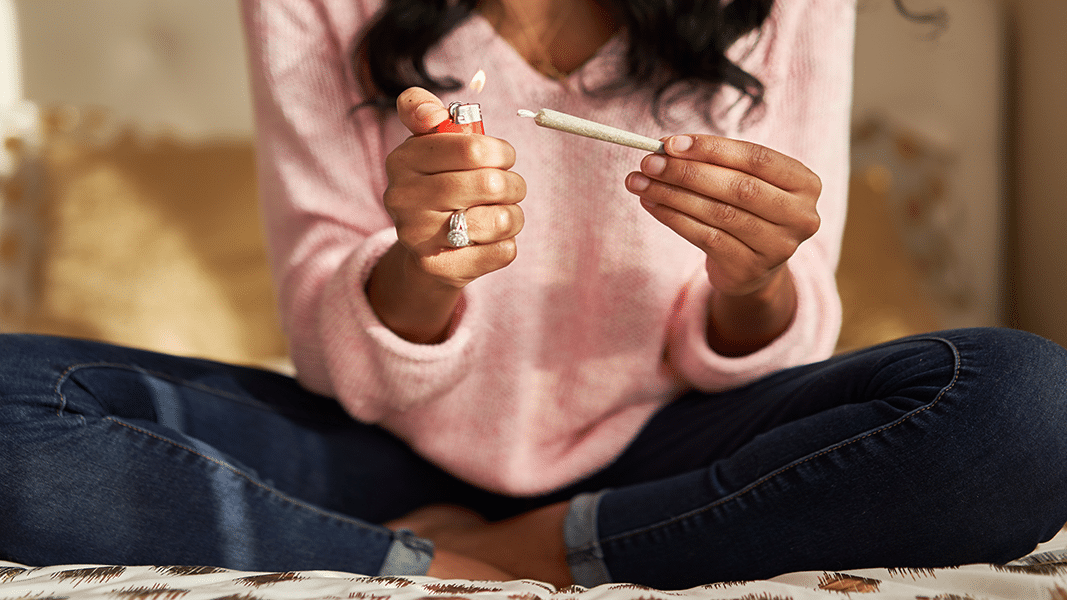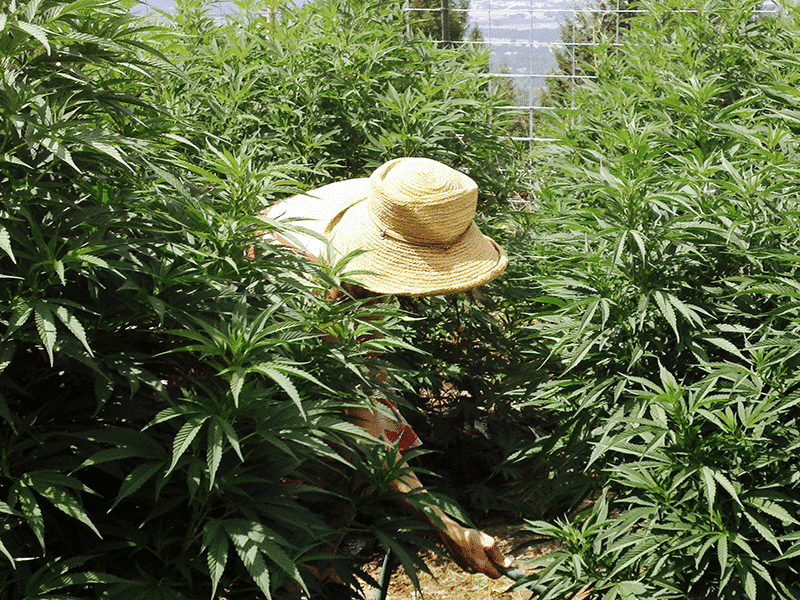“Mom, I need to tell you something.” I glanced up from my book to see my 15-year-old daughter, Melati, standing in the doorway, looking anxious.
“Sure, what’s up?” I said, hiding my concern.

“My friends and I have been smoking weed,” she continued, her face flushed with shame. “We only do it on the weekends, Mama. And not every weekend. But I don’t want to hide it anymore.”
Relief washed over me, followed by sadness. I listened to my almost-fledged child – a brilliant homeschooler who attended college classes, held down a job, played bass in a band, and took care of business – as she explained how her gang of pals would meet up under the stars to perform a kind of ritual together, one that included the smoking of cannabis, almost like a sacrament. Once under its influence, they’d talk about their feelings and creative ideas, play games and music, and just have fun.
“I’m glad you told me about this,” I said, and we had a long talk about cannabis and what the science has to say about its impact on teenagers’ still-developing brains, and about the moderate, responsible use of certain mind-altering substances.
The thing is, Melati knew I’d been using cannabis myself to treat a serious health condition. But this was years before its legalization for adult recreational use in California, and except within discreet cannabis-friendly circles, the consumption of weed purely for pleasure still carried a social (and legal) stigma. My heart ached to witness my teenage daughter’s shame. If cannabis — used mindfully — could enhance pleasure, health, and creativity, how could that kind of goodness be a crime?
A Cannabis-Friendly Era
My, Mary Jane, how times have changed. Adults in more than a dozen states can now sashay through whole candy stores chock-full of flavorful marijuana strains and a dizzying galaxy of products. The science of cannabis therapeutics is finally being taken seriously, with one result that the cannabinoid CBD is now legal in every state. But there’s a lot of catching up to do in this new post-prohibition, cannabis-friendly era. New weed users – especially mamas with families to care for – can be overwhelmed with curiosity, anxiety and questions.
How do I begin? Where do I buy quality cannabis and what kind of product should I try? Should I use cannabis around my children? What shall I do if I find out my teenagers partake? Would weed help my PMS? What about for sex? And how do I talk to my kids, spouse, other moms, and my parents about it?
To help answer these questions and more, we have Weed Mom, a new book by Danielle Simone Brand. Spending an afternoon with Weed Mom is like hanging out with a hip mama friend, one fluent in the language and lay-of-the-land of a wonderful place you’d often heard about and always wanted to visit. Weed Mom’s goal is to assist mamas — no, families — in making healthy, informed decisions about the role of cannabis in their lives.
The book’s preface is a simple Dear John letter penned by Brand, not to an ex-boyfriend, but to Alcohol. With brutal honesty she lists all the ways in which this unreliable companion of many years had let her down, and bluntly lets Alcohol know that she’s found a better partner — in Cannabis.
But it’s in Chapter One where the emotional meat of the book gets laid out on the table. We see Brand dropping her husband off at — yes — a recovery treatment program for cannabis addiction.
“You may’ve thought this guide was a straight-up cannabis love story,” she says, “and that’d be a good guess. But my weed history’s a bit more complex than that, and to show you how I came to adore the plant, I have to first tell you about how and why I hated it.”
She continues. “I hated that something everyone seemed to think was either harmless or could do only good had taken my husband’s brain — already prone to dark, twisty turns — and fucked it up so badly. I’d seen this substance erode my husband’s self-worth and drive its dark tendrils deep into his body and psyche. When I said goodbye to my husband and drove away from the rehab center, where he would spend the next five weeks, my only thought was, ‘I sure as hell hope this works.’”
Just how Brand becomes one of weed’s most knowledgeable and ardent crusaders is a story you’ll have to follow in the book, but that she’s been to hell and back — with cannabis riding shotgun — makes her wisdom all the more hard-won and reliable. This is an honest, unapologetic book for real women.
Consuming Responsibly
“When consuming responsibly, I’m not a different person or a chemically forged supermom,” says Brand. “What I am is a less harried version of me. A more chill, more appreciative, and, quite honestly, more nurturing version — like the me from a universe just one click away, a me who doesn’t stress nearly as much about things that don’t actually require stressing.”
Beneath the chill girlfriend tone is a mama who knows her shit (by the way, Brand occasionally tosses in wry profanity, so I figured I’d follow suit). The book is deeply researched and structured to build our cannabis knowledge in layers. Brand first lays the foundation with a crash course in cannabinoid science. Next, she surveys the fascinating social and political history of cannabis through the ages, up to and including its current state and federal legal status, and then tops us off with research into common conditions treated with cannabis therapeutics. Newly-equipped with weed chops, we’re now ready to play the Five W’s of Weed Game: Why, What, Where, When and with Whom, with helpful advice on the pros and cons of flowers versus extracts versus edibles, how to find other ganja-loving moms, and how weed can help make sex something busy, tired mamas actually want to make time for.
Along the way, Brand weaves in commentary from respected experts and activists, anecdotes from other weed moms, and best yet, her own personal experience, which she dishes out with such openness and compassion I felt profoundly moved reading her story.
She also addresses an issue not often discussed in cannabis circles: the negative attitudes and legal consequences that women of color are more often subjected to in the cannabis space, due to entrenched racial and economic disparities. Brand describes how – even in weed-friendly California – Black moms report being harassed by police for legally sparking up in their own backyards or are cast the side-eye while shopping in dispensaries located in affluent white neighborhoods. Even more troubling is the proportionally higher number of women of color serving long jail sentences for cannabis-related offenses.
Straightforward Tips
Brand offers straightforward tips on how to talk about weed to kids — from tots (this is Mommy’s medicine that helps her feel better) to teens, when the best bet is to “choose honesty about cannabis and other drugs in the degree of detail they are ready for, not relying on fear-mongering or threats of punishment, but telling them what science says about young brains and cannabis.”
Brand continues. “Because it’s not just for our kids’ own health and safety that we teach them about cannabis. When they learn the complex social and political history of the plant — when they gain the skills to think critically about policy, governance, and social justice — they’ll become better citizens. Better policymakers. Better entrepreneurs. Better environmentalists. Better people.”
Brand doesn’t wiggle away from discussing side effects, risks, downsides, safety issues, harm reduction, and cannabis use disorder. She explains what can help if you get too high, or how to recognize if you have a dependency problem, particularly with regards to possible negative impacts of cannabis on your kids, or your ability to carry on a healthy, productive life. Brand loves cannabis, but she’s no couch-locked slacker. She likes to get shit done, and assumes you do, too.
Sometimes Brand tries to fit in so much useful information that the book can feel overloaded, with some long paragraphs, passages and anecdotes that could have used a bit of thoughtful paring. But if the goal is to arm moms with enough cannabis knowledge to help them make informed choices, she righteously succeeds.
The most profound gift embedded in this book is how Brand celebrates mothers. She knows our struggle. She knows how hard it is for mamas to carve out time and space to unwind, replenish, be in the moment. Pleasure is our human right, she asserts. The desire to mindfully partake of a plant that can benefit us — and, by association, our families — is not only something we shouldn’t be ashamed of, but ought to claim as our own.
“In my view,” says Brand, “there’s nothing inherently wrong with trying to alter your state of mind or being. Yoga is one way I do this. Meditation is another. Being thoughtful about my food choices, the media I consume, and the amount of exercise I get all come into play here for me — and I’d guess for you, too. I see little distinction between these things and cannabis; when used thoughtfully, all are pieces of self-care that alter my ordinary state just enough to help me function optimally and feel great. “
Applying the Weed Mom ethos, if cannabis makes Mama happy, it’ll make everybody happy.
[Read excerpt from Weed Mom by Danielle Simone Brand.]
Melinda Misuraca is a Project CBD contributing writer with a past life as an old-school cannabis farmer specializing in CBD-rich cultivars. © Copyright, Project CBD. May not be reprinted without permission.
Recommended Readings
Weed Mom
Excerpted from “The Canna-Curious Woman’s Guide to Healthier Relaxation, Happier Parenting, and Chilling TF Out” by Danielle Simone Brand.
Women Patient Cannabis Activists Fighting for Change
They saw a problem that needed a solution.
Luther Burbank, Cannabis & Me
The life and times of a CBD-rich garden in Northern California.




